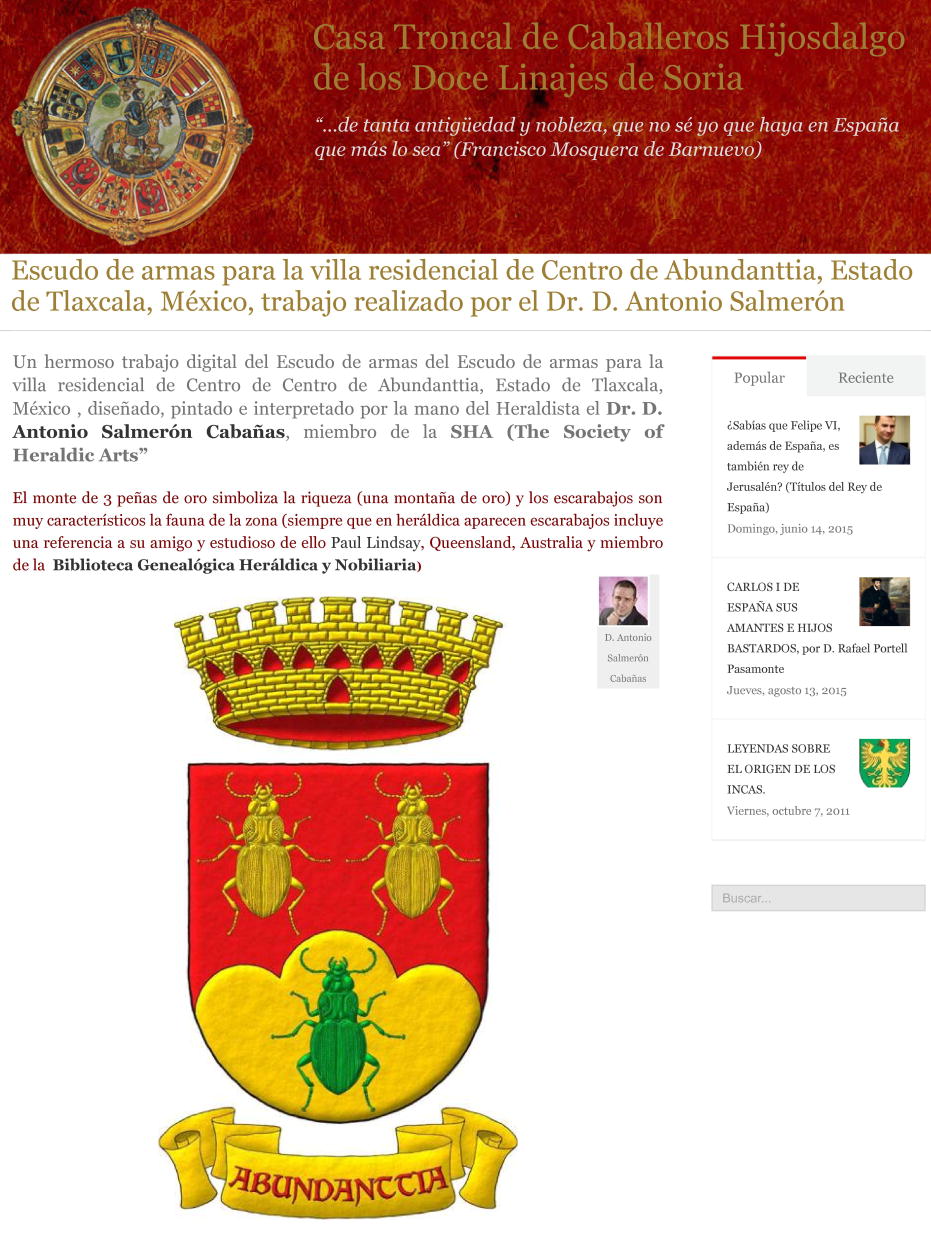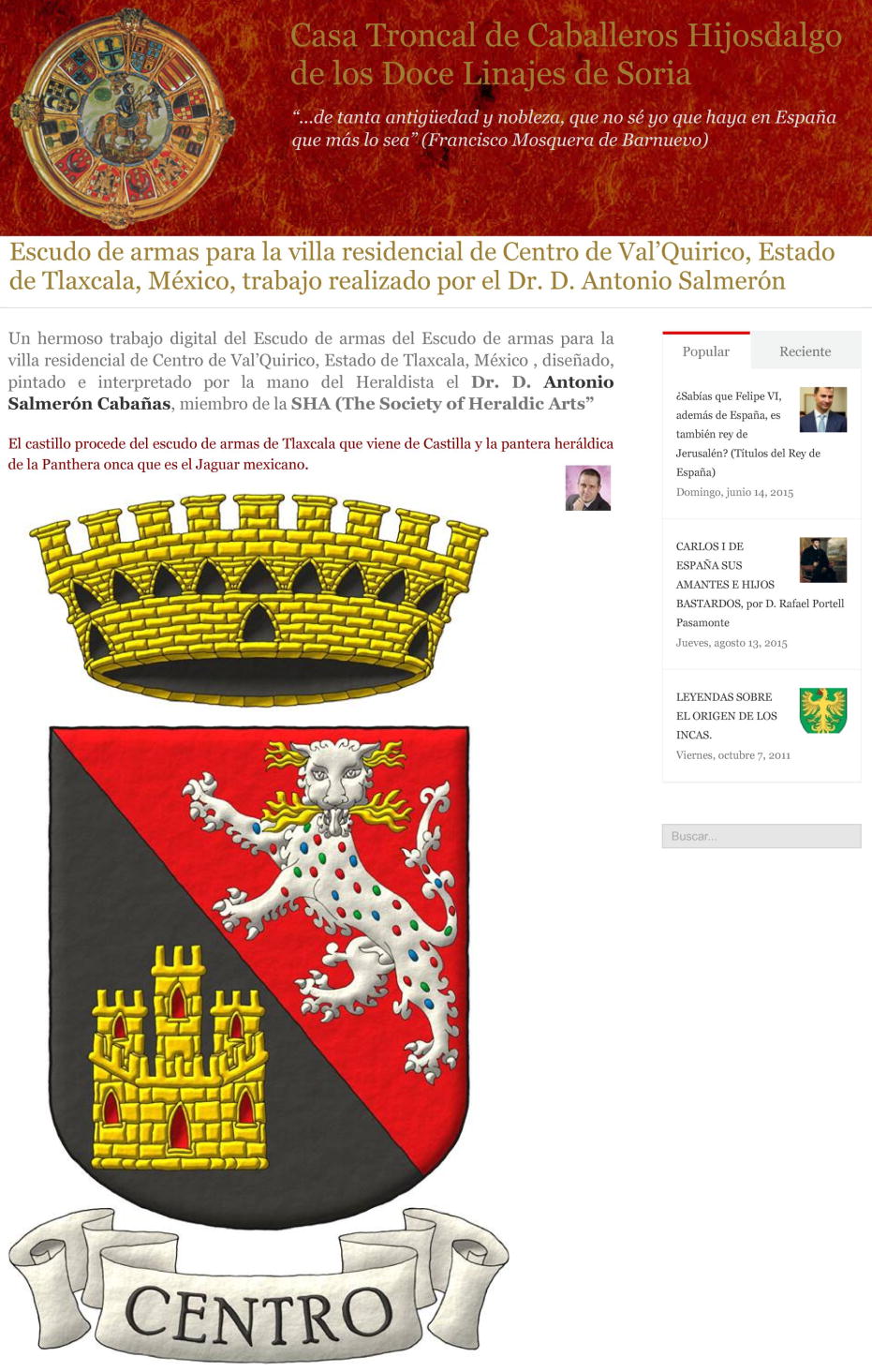
Israel
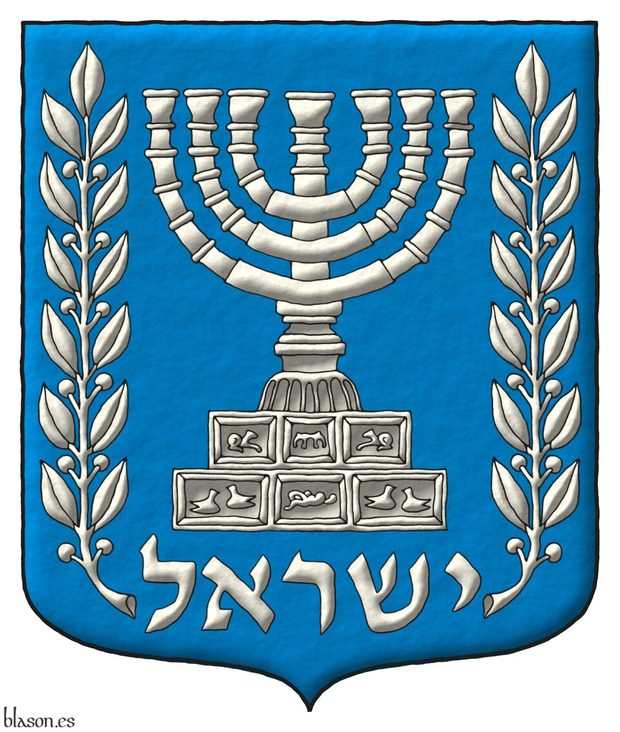
Israel~ישראל.
Azure, a Menorah between two olive branches Argent; in base the legend
«ישראל» Argent.
Interpreted coat of arms: with a rounded and pointed shape; illuminated with metal argent and color azur; outlined with sable; and a Watercolor finish.
Blazon keywords: Without divisions, Azure, One, Menorah, Argent, Accosted, Two, Branch, Olive tree, Tree and Motto (identification).
Style keywords: Ogee, Illuminated, Outlined in sable and Freehand.
Classification: Coat of arms, Interpreted, Civic and State of Israel.
Bearer: Israel.


Ukraine
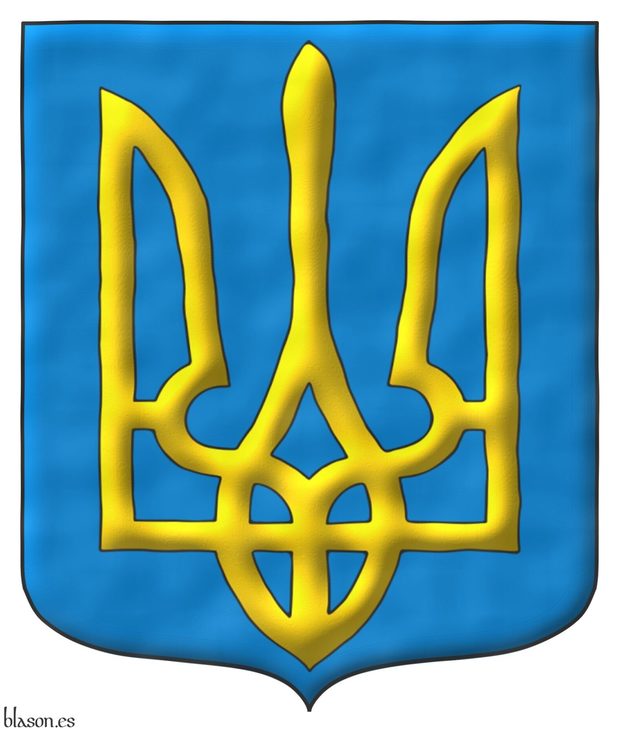
Trident~Tryzub.
Azure, a Tryzub Or.
Interpreted coat of arms: with a rounded and pointed shape; illuminated with metals or and color azure; outlined with sable; and a Watercolor finish.
Blazon keywords: Without divisions, Azure, Trident and Or.
Style keywords: Ogee, Illuminated, Outlined in sable and Freehand.
Classification: Coat of arms, Interpreted, Civic and State of Ukraine.
Bearer: Ukraine.


Ukraine, pointed
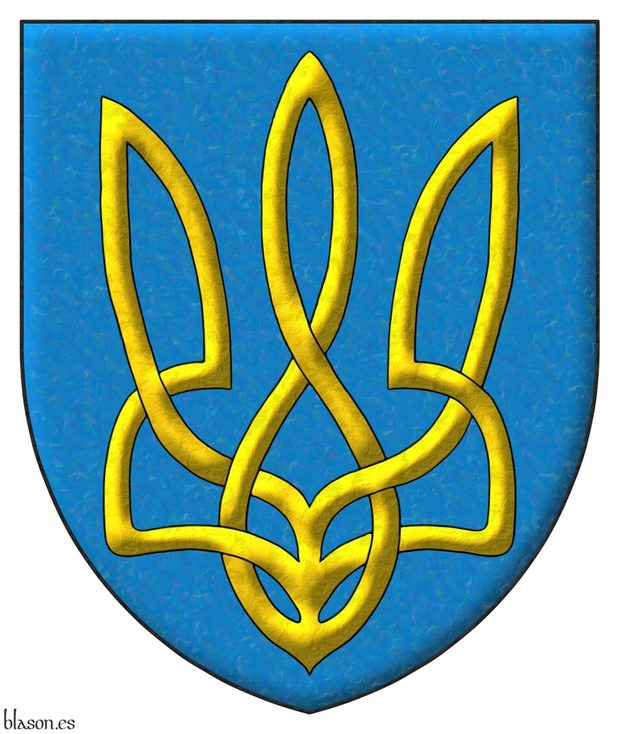
Azure, a Tryzub Or.
Escudo de azur, un tryzub de oro.
Interpreted coat of arms: with a pointed shape; illuminated with metals or and color azure; outlined with sable; and an iridescent finish for the field and metallic of the tryzub.
Blazon keywords: Without divisions, Azure, Trident and Or.
Style keywords: Ogee, Illuminated, Outlined in sable, Iridescent (nacar) and Soft metal.
Classification: Coat of arms, Interpreted, Civic and State of Ukraine.
Bearer: Ukraine.


![Ver [Uhagón y Guardamino, F. R.; 1904] en referencias bibliográficas. Libro abierto, hojas de plata, filo de oro, guardas de gules, tapas de sable.](../css/Libro.Bibliografia.png)
Uhagón y Guardamino, F. R.; 1904
Francisco Rafael Uhagón y Guardamino, I Marqués de Laurencín, Director de la Real Academia de la Historia, Caballero de la Orden de Calatrava, «Libro de la Cofradía de Caballeros de Santiago de la Fuente, Fundada por los Burgaleses en Tiempo de Don Alfonso XI» noticia bibliográfica, publicada en la Revista de Archivos, Bibliotecas y Museos, impresa por la Tipográfica de la Revista de Archivos, Bibliotecas y Museos, calle de Olid 8, Madrid, 1904.
This article provides a bibliographical account of the illuminated manuscript [Cofradía de Santiago; Century XIV].
Bibliographical reference of century XX.
Classification: Article, Castilian language and In black and white.
Author: Uhagón y Guardamino, Francisco Rafael.
External link:


![Ver [Abundanttia, Val’Quirico, Tlaxcala, Mexico in Twelve Lineages] en enlaces recomendados. Áncora de oro y la divisa enlace.](../css/Ancora.Enlace.png)
Abundanttia, Val’Quirico, Tlaxcala, Mexico in Twelve Lineages
Publication of my heraldic artwork on the blog Twelve Lineages of Soria under the following headline: Coat of arms for the residential town of Abundanttia, State of Tlaxcala, Mexico, work by Dr. Antonio Salmerón Cabañas.
Categories: Link, Civic, United Mexican States, Freehand, Or, Gules, Vert, Mural crown, Crown, Beetle, Trimount and Motto (identification).
Root: Twelve Lineages of Soria.


![Ver [Centro, Val’Quirico, Tlaxcala, Mexico in Twelve Lineages] en enlaces recomendados. Áncora de oro y la divisa enlace.](../css/Ancora.Enlace.png)
Centro, Val’Quirico, Tlaxcala, Mexico in Twelve Lineages
Publication of my heraldic artwork on the blog Twelve Lineages of Soria under the following headline: Coat of arms for the residential town of Centro de Val’Quirico, State of Tlaxcala, Mexico, work by Dr. Antonio Salmerón Cabañas.
Categories: Link, Civic, United Mexican States, Freehand, Or, Sable, Gules, Argent, Mural crown, Crown, Party per bend, Panther and Rampant.
Root: Twelve Lineages of Soria.


![Ver [Vera-Ortiz, J.A.; 2009] en referencias bibliográficas. Libro abierto, hojas de plata, filo de oro, guardas de gules, tapas de sable.](../css/Libro.Bibliografia.png)
Vera-Ortiz, J.A.; 2009
Jorge A. Vera-Ortiz, «Linaje emeritense de don Juan Antonio de Vera y Zúñiga, un pícaro conde genealogista y una creencia muy arraigada», Bulletin No. 257 of the Argentine Institute of Genealogical Sciences, pages 27 to 50, Buenos Aires, November-December 2009.
This article examines the lineage of Don Juan Antonio de Vera y Zúñiga, a count whose life and genealogical work are marked by both wit and controversy. The author, Jorge A. Vera-Ortiz, analyzes how deeply rooted beliefs about the lineage of this figure have influenced the historical perception of his legacy. In this way, from 1617 to 1635, the accumulation of studies that appeared exalting the lineage of the Count of La Roca is astonishing. These works were sometimes published under the names of well-known authors and genealogists, and sometimes under less familiar names, but many authors assume that these works were part of the fertile imagination of Juan Antonio de Vera y Zúñiga himself, who published them under pseudonyms to give them greater authority. The book [Mogrovejo de la Cerda, J.; 1636] would be an example of this practice.
Bibliographical reference of century XXI.
Classification: Article and Castilian language.
The author is Vera-Ortiz, Jorge A..
Bibliographical reference mentioned in the following article:
External resource:
Internal resources: A digital and partial transcription of this article..


![Ver [Cervantes Saavedra, M. de; 1605] en referencias bibliográficas. Libro abierto, hojas de plata, filo de oro, guardas de gules, tapas de sable.](../css/Libro.Bibliografia.png)
Cervantes Saavedra, M. de; 1605
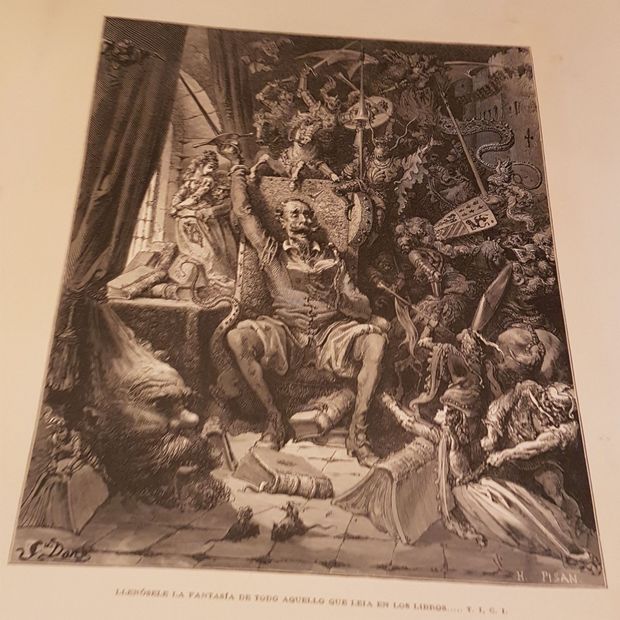
Miguel de Cervantes Saavedra, «El Ingenioso Hidalgo Don Quijote de la Mancha», edition with illustrations by Gustavo Doré, engravings by H. Pisan, in 2 volumes, printed by Imprenta y Librería Religiosa y Científica del Heredero de Don Pablo Riera, Robador Street, 24 and 26, Barcelona, 1875.
Original publication date
The original edition of «El Ingenioso Hidalgo Don Quijote de la Mancha» was published in 1605, with the second part released in 1615.
Illustrated edition details
This 1875 edition is notable for its elaborate illustrations by Gustavo Doré, a renowned French artist, and the detailed engravings by H. Pisan. The illustrations add a rich visual element to Cervantes' classic text, making this edition a significant artistic interpretation of the original work.
First Part, Chapter XVIII, excerpt
«—That knight you see over there with the yellow arms», Or,
«who bears on his shield a crowned lion,
bowed at the feet of a maiden,
is the valiant Laurcalco,
lord of the Silver Bridge;
the other with the golden flowered arms,
who bears on his shield three silver crowns on a blue field,
is the feared Micocolembo, grand duke of Quirocia;
the other with giant limbs,
who stands to his right hand,
is the never fearful Brandabarbarán de Boliche,
lord of the three Arabias,
who comes armed with that serpent's hide and
bears on his shield a door, which, according to legend,
is one of the doors of the temple that Samson destroyed when
he avenged himself on his enemies with his death.
But turn your eyes to the other side and
you will see before and in front
of the other army the always victorious and never defeated
Timonel of Carcajona, prince of New Biscay,
who comes armed with quartered arms,
blue, green, white, and yellow, and bears on his shield
a golden cat on a tawny field,
with an inscription that says «Miau»,
which is the beginning of his lady's name, who,
as they say, is the incomparable Miulina,
daughter of the duke Alfeñiquén of Algarve;
the other who presses down the back of that powerful steed,
who bears arms as white as snow and a shield white and
without any charges, is a novice knight, of French nation,
named Pierres Papín, lord of the baronies of Utrique;
the other who strikes the flanks with the iron-shod heels
of that painted and swift zebra and bears
the blue vair arms,
is the powerful duke of Nerbia, Espartafilardo del Bosque,
who bears as a charge on his shield an asparagus plant,
with an inscription in Castilian that says: «Tracks my fate».
And in this way, he went on naming many knights
from one and the other squadron that he imagined,
and to each of them, he gave
arms, colors, charges, and mottos on the spot,
driven by the imagination of his never-before-seen madness, and,
without stopping, he continued saying...».
Bibliographical reference of century XVII.
Classification: Castilian language and In black and white.
Author: Cervantes Saavedra, Miguel de.
The following articles cite this bibliographic reference:

Continue with: de Pando Villarroya, J. L. P. V.; 2006.
-
Language
-
Categories of heraldry
-
Divisions of the field
- Without divisions
- Party per pale
- Party per fess
- Party per bend
- Party per bend sinister
- Tierce
- Tierce sinister
- Tierced per pale
- Tierced per fess
- Tierced per bend
- Tierced pallwise inverted
- Quarterly
- Quarterly per saltire
- Gyronny
- Party per fess, the chief per pale
- Party per pale, the sinister per fess
- Party per fess, the base per pale
- Party per pale, the dexter per fess
- Chapé
- Chaussé
- Embrassé
- Contre-embrassé
- Party per chevron
- Enté
- Enté en point
- Flanched
-
Metals
-
Colours
-
Furs
-
Other tinctures
-
Ordinaries and sub-ordinaries
-
Diminutives of the ordinaries
-
Geometric charges
-
Composite ordinaries
-
Inanimate charges from Nature
Atom, Crescent, Diamond, Emerald, Estoile, Increscent, Lightning flash, Moon, Mount, Mullet, Mullet of four points, Orbital, Plough of Ursa Major, Rainbow, Ray of the sun, River, Sea, Snowflake, Sun, Sun in splendour, Sun of May, Trimount, Water and Wave.
-
Vegetal charges from Nature
Acorn, Apple, Apple tree, Ash, Bluebonnet, Camellia, Chrysanthemum, Cinquefoil, Cornflower, Dogwood flower, Double rose, Elm, Fleur de lis, Flower, Gourd, Holm oak, Hop cone, Kapok tree, Laurel, Lily, Linden, Lotus flower, Madonna lily, Mexican cedar tree, Oak, Olive tree, Palm tree, Plantain plant, Pomegranate, Poplar leaf, Rose, Shamrock, Sunflower, Thistle, Tree, Tulip, Vine and Wheat.
-
Animal charges from Nature
Badger, Bald eagle, Barbel, Barn owl, Bear, Beaver, Beetle, Bighorn sheep, Blackbird, Boar, Brach hound, Bull, Doe, Dog, Dolphin, Dove, Eagle, Elephant, Falcon, Female figure, Fish, Flame, Fly, Fox, Frog, Goat, Goldfinch, Goose, Heron, Horse, Hummingbird, Jaguar, Lark, Leopard, Lion, Lion passant, Lion rampant guardant, Lioness, Lynx, Male figure, Martlet, Merino ram, Owl, Panther, Parrot, Peacock, Pelican, Pelican in her piety, Puffin, Quetzal, Raven, Roe deer, Rooster, Savage, Seagull, Serpent, She-wolf, Stag, Starling, Talbot, Tyger, Vulture, Warren hound and Wolf.
-
Parts of natural charges
Arm, Beak, Branch, Caboshed, Chest, Claw, Covert, Dorsal fin, Eagle claw, Ermine spot, Escallop, Feather, Foot (palmiped), Foreleg, Forepaw, Hand, Head, Heart, Hoof, Leaf, Neck, Ostrich feather, Palm frond, Paw, Roe deers' attires, Shoulder, Sprig, Stags' attires, Stem, Swallow-tail, Tail, Tail addorsed, Tail fin, Talon, Tooth, Trunk, Trunk (elephant), Two hands clasped, Two wings in vol, Udder, Wheat spike, Wing and Wrist.
-
Artificial charges
Ace of spades, Anchor, Anvil, Arch, Arm vambraced, Armillary sphere, Arrow, Axe, Bell, Bell tower, Beret, Bonfire, Book, Bookmark, Bow, Branding iron, Bridge, Broken, Buckle, Cannon, Cannon dismounted, Cannon port, Canopy roof, Carbuncle, Castle, Celtic Trinity knot, Chain, Chess rooks, Church, Clarion, Clay pot, Closed book, Club, Column, Comb, Compass rose, Conductor's baton, Cord, Covered cup, Crozier, Crucible, Cuffed, Cup, Cyclamor, Dagger, Double vajra, Drum, Ecclesiastical cap, Fanon, Federschwert, Fleam, Four crescents joined millsailwise, Galician granary, Garb, Gauntlet, Geometric solid, Grenade, Halberd, Hammer, Harp, Host, Hourglass, Key, Key ward, Knight, Knot, Lantern, Letter, Line, Loincloth, Menorah, Millrind, Millstone, Millwheel, Monstrance, Mortar, Mullet of six points pierced, Nail, Non-classic artifact, Norman ship, Number, Oar, Oil lamp, Open book, Page, Pair of scales, Parchment, Pestle, Piano, Pilgrim's staff, Plough share, Polish winged hussar, Port, Portcullis, Potent, Quill, Ribbon, Rosette of acanthus leaves, Sabre, Sackbut, Sail, Scroll, Scythe, Sheaf of tobacco, Ship, Skirt, Spear, Spear's head, Stairway, Star of David, Step, Sword, Symbol, Tetrahedron, Torch, Tower, Trident, Trumpet, Turret, Two-handed sword, Wagon-wheel, Water-bouget, Wheel, Winnowing fan and With a turret.
-
Immaterial charges
Angel, Archangel, Basilisk, Dragon, Dragon's head, Garuda, Golden fleece, Griffin, Heart enflamed, Justice, Mermaid, Our Lady of Mercy, Ouroboros, Paschal lamb, Pegasus, Phoenix, Sacred Heart of Jesus, Saint George, Sea-griffin, Trinity, Triton, Unicorn, Winged hand and Wyvern.
-
External elements
-
Heraldic creations
-
References
-
Formats
-
Keywords on this page
Accosted, Iridescent (nacar), Article, Azure, Bibliography, Ogee, Crown, Mural crown, Outlined in sable, Dictionary, Motto (identification), Two, In black and white, Link, Beetle, Coat of arms, State of Israel, State of Ukraine, United Mexican States, Genealogy, Gules, Illuminated, Interpreted, Israel, Castilian language, Menorah, Soft metal, Trimount, Olive tree, Or, Panther, Argent, Without divisions, Civic, Branch, Rampant, Sable, Century XVII, Century XX, Century XXI, Vert, Freehand, Trident, Party per bend, Twelve Lineages of Soria, Ukraine, One and Tree.

